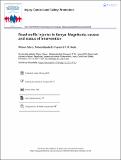| dc.contributor.author | Wilson Odero, Meleckidzedeck Khayesi, PM Heda | |
| dc.date.accessioned | 2020-08-11T08:45:52Z | |
| dc.date.available | 2020-08-11T08:45:52Z | |
| dc.date.issued | 2003-04-01 | |
| dc.identifier.citation | 330 | en_US |
| dc.identifier.issn | 1566-0974 (Print) | |
| dc.identifier.uri | https://repository.maseno.ac.ke/handle/123456789/1967 | |
| dc.description | Journal homepage: https://www.tandfonline.com/loi/nics19 | en_US |
| dc.description.abstract | Road traffic crashes exert a huge burden on Kenya’s economy and health care services. Current interventions are sporadic, uncoordinated and ineffective. This report offers a descriptive analysis of secondary data obtained from a variety of published literature and unpublished reports. Over three thousand people are killed annually on Kenyan roads. A fourfold increase in road fatalities has been experienced over the last 30 years. More than 75% of road traffic casualties are economically productive young adults. Pedestrians and passengers are the most vulnerable; they account for 80% of the deaths. Buses and matatus * Matatus are small-scale public transport vehicles in Kenya. These vehicles are important in public transport but they flagrantly violate traffic rules. are the vehicles most frequently involved in fatal crashes. Characteristics of crashes vary considerably between urban and rural settings: pedestrians are more likely to be killed in urban areas, whereas passengers are the majority killed on intercity highways that transverse rural settings. Road safety interventions have not made any measurable impact in reducing the numbers, rates and consequences of road crashes. Despite the marked increase in road crashes in Kenya, little effort has been made to develop and implement effective interventions. Impediments to road traffic injury prevention and control include ineffective coordination, inadequate resources and qualified personnel, and limited capacity to implement and monitor interventions. There is need to improve the collection and availability of accurate data to help in recognising traffic injury as a priority public health problem, raising awareness of policymakers on existing effective countermeasures and mobilizing resources for implementation. Establishment of an effective lead agency and development of stakeholder coalitions to address the problem are desirable. | en_US |
| dc.publisher | Taylor & Francis Group | en_US |
| dc.subject | Injury Control , Safety Promotion | en_US |
| dc.title | Road traffic injuries in Kenya: magnitude, causes and status of intervention | en_US |
| dc.type | Article | en_US |

